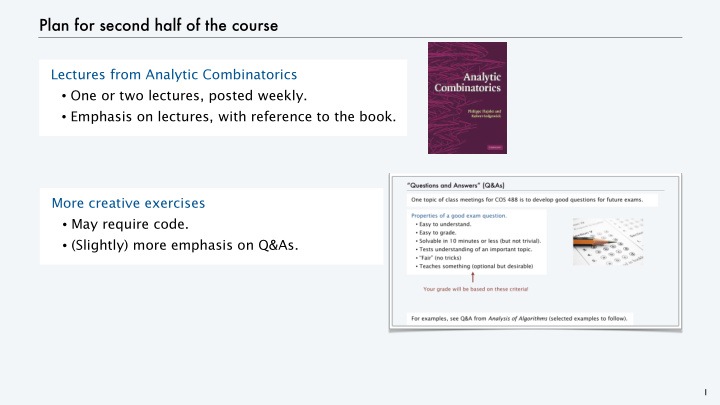



Plan for second half of the course Lectures from Analytic Combinatorics • One or two lectures, posted weekly. • Emphasis on lectures, with reference to the book. More creative exercises • May require code. • (Slightly) more emphasis on Q&As. 1
AC basics Q&A 1 Q. Match each description on the left to 0 or 1 of the symbolic specifications on the right ( ODD denotes the set of odd numbers). compositions SEQ ODD (SEQ( Z )) compositions into M parts SEQ(SEQ ODD ( Z )) compositions into odd parts SEQ( Z ) compositions into an odd number of parts SEQ M ( Z ) compositions into distinct parts MSET( Z ) partitions MSET ODD ( Z ) partitions into M parts PSET( Z ) partitions into odd parts MSET(SEQ ODD ( Z )) partitions into an odd number of parts MSET ODD (SEQ( Z )) partitions into distinct parts 2
AC Basics Q&A 2: cyclic bitstrings Def. A cyclic bitstring is a cyclic sequence of bits 0 1 0 0 0 1 1 0 0 1 1 0 0 1 0 0 1 1 0 0 1 0 0 1 1 1 0 0 0 1 1 C 1 = 2 1 0 1 1 0 0 1 C 3 = 4 1 0 1 1 C 2 = 3 1 0 C 4 = 6 C 5 = 8 Q. How many N -bit cyclic bitstrings ? 3
Q&A example: cyclic bitstrings Q. How many N -bit cyclic bitstrings ? 0 1 One possibility 0 0 1 1 • Solution is “easy”. 0 1 • Create an exam question with appropriate hints. 0 1 Another possibility 1 0 0 1 • Solution is “difficult” or “complicated”. 0 1 • Figure out a way to simplify. 0 0 • Or, think about a different problem. 1 0 1 1 1 0 Third possibility • Problem you thought of is a “classic”. C 4 = 6 • Use OEIS. 4
1 0 page 18 1 1 0 0 0 0 1 0 1 1 C 3 = 4
page 64
k 1 2 3 4 5 6 7 8 9 1 1 2 2 4 2 6 4 6 𝜒 ( k ) 1 + (2 z ) 2 + (2 z ) 3 + (2 z ) 4 + (2 z ) 5 1 − 2 z = 2 z 1 ln + . . . 2 3 4 5 1 − 2 z 2 = 2 z 2 + (2 z 2 ) 2 1 ln + . . . 1 2 1 − 2 z 3 = 2 z 3 + (2 z 3 ) 2 1 ln + . . . 1 2 1 − 2 z 4 = 2 z 4 1 ln + . . . 1 1 − 2 z 5 = 2 z 5 1 ln + . . . 1
AC Basics Q&A 2 Q. How many cyclic bitstrings of length 10 ? construction N ( z ) = OGF [ z 10 ] N ( z ) = result 9
AC Basics Q&A 3 Q. How many unimodal permutations of length n ? I = increasing perms D = decreasing perms U = unimodal perms definitions I = SET ( Z ) D = U = constructions I ( z ) = e z EGFs D ( z ) = U ( z ) = U n = exact result 10
AC Basics Q&A 4 Q. Mappings with every character appearing 2 or 0 times . C = Z + Z ? SET 2 ( C ) M = SET ( Y ) Y = CY C ( Z ? C ) constructions 1 1 C ( z ) = z + 1 2 zC ( z ) 2 M ( z ) = Y ( z ) = ln EGF equations 1 − zC ( z ) 1 − zC ( z ) √ C ( z ) = 1 − 1 − 2 z 2 EGFs z 1 M ( z ) = (1 − z/ ρ ) α ∼ f ( ρ ) f ( z ) √ Γ ( α ) ρ − n n α − 1 [ z n ] 1 − 2 z 2 � 1 � = √ π Γ 2 √ ⌘ n ⇣ n (2 n )![ z 2 n ] M ( z ) ∼ (2 n )! 2 n ⌘ 2 n ⇣ 2 n n ! ∼ 2 π n ~-approximation ∼ 2 √ π n e e 11
Recommend
More recommend